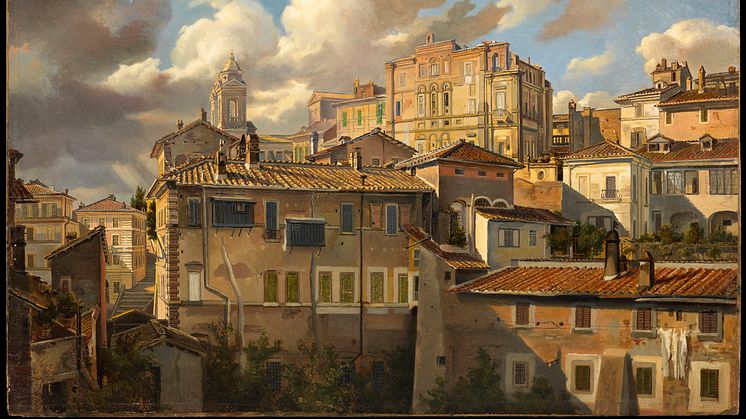
Press release -
New acquisition: Eugen Napoleon Neureuther, View of Monte Pincio and the Palazzo Zuccari, Rome
Nationalmuseum has acquired a Rome cityscape painted in 1837 by German artist Eugen Napoleon Neureuther. Neureuther worked mainly in Munich but toured Italy in 1837–38. This depiction of the view from the bohemian quarter looking towards Monte Pincio dates from his time in Rome.
Eugen Napoleon Neureuther (1806–82) studied at the academy of fine art in Munich. Accompanied by his brother, he set out for Italy in February 1837. By 6 April the Neureuther brothers had arrived in Rome, where they stayed until October with a brief interlude over the summer. It was during their time in Rome that Neureuther painted this view of the scene looking towards Monte Pincio and the Trinità dei Monti church. The vantage point appears to be a house on the east side of Via dei Due Macelli in the bohemian quarter near the Spanish Steps, looking out over the courtyard and the buildings on the south-western slopes of Monte Pincio. At left, we can glimpse the steps leading up to the square in front of Trinità dei Monti from what is now the Piazza Mignatelli. An imposing building with a taller central section dominates the middle ground: the Palazzo Zuccari, which figured prominently in the life of the German artistic community in Rome. In the early 19th century, the Palazzo Zuccari was the residence of the Prussian consul general, Jakob Salomon Bartholdy. He commissioned four German artists, members of the Nazarene movement, to paint frescoes in the palace (1816–17, moved to the Alte Nationalgalerie, Berlin, in 1887). Among them was Peter Cornelius, Neureuther’s teacher. The Palazzo Zuccari’s links to German culture, which in Neureuther’s case were also personal, may explain why the building is so prominently placed in his composition.
Afternoon or evening light illuminates the buildings, while dark rain clouds appear to have recently passed by overhead. Neureuther combines topographical precision with attentive observation of transient weather conditions, which was typical of landscape painting of the period. The roofs in the foreground and the anonymous, slightly shabby façades with closed shutters and washing hung out to dry are a piece of everyday life that appears to have been captured by chance. In fact, what we are looking at is a geometrically balanced composition. The truncated building at left, whose shaded terrace may be the vantage point from which the artist observed the cityscape, lends depth and credibility to the image.
Neureuther’s ambitious view of Rome complements Nationalmuseum’s previously acquired Italian landscape paintings from the first half of the 19th century by French and Danish artists. The purchase of this work was made possible by a generous donation from the Wiros Fund. Nationalmuseum has no budget of its own for new acquisitions, but relies on gifting and financial support from private funds and foundations to enhance its collections of fine art and craft.
Inventory number:
NM 7350
Media contacts:
Martin Olin, Head of Research and Loans: martin.olin@nationalmuseum.se, +46 8 5195 4310
Mattias Robertson, Press Officer: press@nationalmuseum.se, +46 767 234632
Categories
Nationalmuseum is Sweden’s premier museum of art and design. The collections comprise older paintings, sculpture, drawings and graphic art, and applied art and design up to the present day. The museum building is currently under renovation and scheduled to open again in 2018. In the meantime, the museum will continue its activities through collaborations both in Sweden and abroad as well as temporary exhibitions at Nationalmuseum Design at Kulturhuset Stadsteatern in Stockholm. Nationalmuseum has partnerships with Svenska Dagbladet and the Grand Hôtel Stockholm, and acknowledges the support of FCB Fältman & Malmén.

